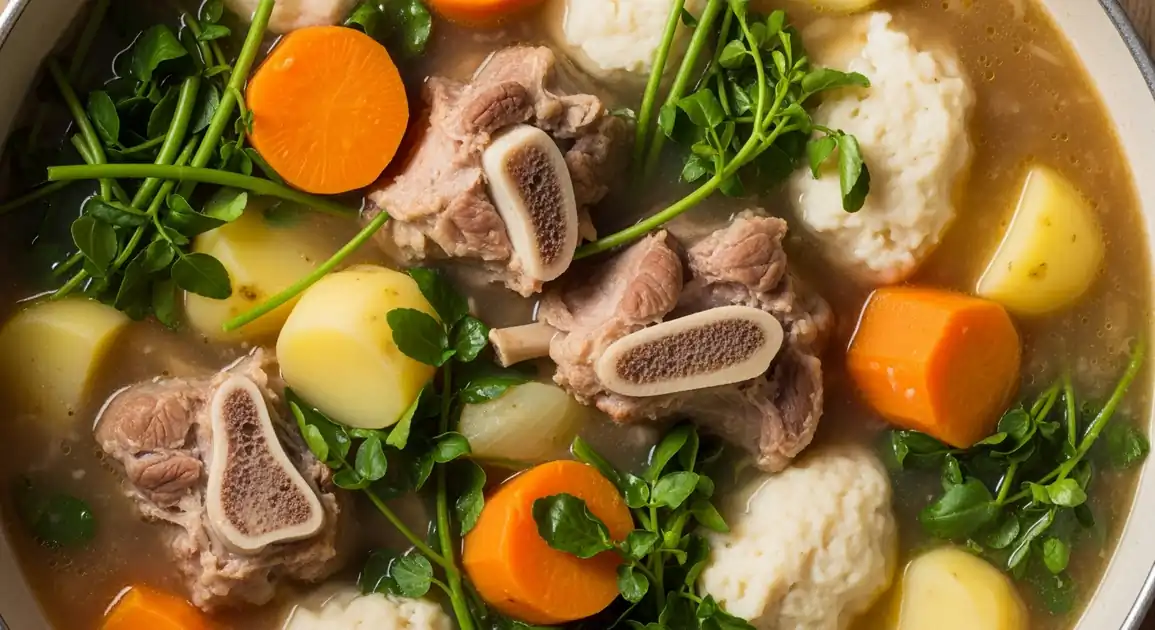Boil Up
Boil Up

Description
Boil Up is a cornerstone of traditional Māori cuisine found throughout New Zealand, primarily cooked in homes and served at community gatherings (hui, tangi) on marae. While not commonly found in mainstream restaurants, dedicated Māori kai takeaways and specific events offer opportunities to try this comforting dish.
Dietary Information
Serving information
Serving style
Served hot in a deep bowl, often in generous portions. Eaten with a spoon and fork. It's a complete meal in itself.
Quick facts
Event dependent. Takeaway shops usually operate standard lunch and dinner hours (e.g., 11 AM - 7 PM, varies greatly).
Safety Tips
What to Look For
-
Served piping hot
Ensures the dish is at a safe temperature, minimizing bacterial risk, especially crucial at events or takeaways.
-
Meat tender and falling off the bone
Indicates it has been cooked long enough for both safety and quality.
-
Vegetables soft but not disintegrated
Shows proper cooking time – mushy vegetables might indicate it's old or overcooked.
-
Doughboys appear light and fully cooked
Should be fluffy, not dense or doughy in the center.
-
Clean serving environment
Observe the hygiene practices of the vendor or serving area, especially at temporary setups like markets or events.
What to avoid
-
Lukewarm temperature
Food held in the 'danger zone' (not hot enough or cold enough) allows bacteria to multiply. Insist on hot food.
-
Meat that looks dry or tough
Could indicate undercooking or poor quality reheating.
-
Greens that look slimy or overly yellowed
Suggests the greens were old or the dish has been sitting too long.
-
Dry, hard, or overly dense doughboys
Signifies they might be stale, improperly cooked, or reheated poorly.
-
Vendors with poor hygiene practices
Avoid places where food handling looks unsanitary (e.g., dirty utensils, poor hand hygiene).
Price information
Price range
Budget tips
- Community events or fundraisers may offer Boil Up at lower prices.
- Takeaway shops specializing in Māori kai provide set prices per portion.
- Home cooking is the most common and cost-effective way it's consumed.
- Price often reflects portion size, which is usually generous.
Value indicators
- Generous portion of meat, vegetables, and doughboys.
- Rich, flavorful broth.
- Served piping hot.
- Authentic ingredients used (e.g., kūmara, pūhā/watercress).
Where to Find This Dish
Marae (Community Meeting Grounds)
Commonly prepared and served during hui (gatherings) or tangi (funerals) as part of manaakitanga (hospitality). Not typically open to the public unless invited or during specific public events.
Local Marae (search specific regions)
During scheduled events
Māori Kai Takeaways
Specialty shops focusing on traditional Māori food, often found in areas with significant Māori populations.
Search 'Māori kai takeaways' in specific towns/cities
Lunch, Dinner (shop dependent)
Community Fundraisers / Festivals
Sometimes sold as a fundraising meal by community groups or featured at cultural festivals.
Local community centers, Festival grounds
Event specific times
Vendor Tips
- Respect cultural protocols if attending an event on a marae.
- Ask about the ingredients if you have dietary concerns (e.g., type of meat used).
- Be prepared for hearty, filling portions.
How to Order
Regional Variations
-
Bacon Bone Boil Up
(Bacon Bone Boil Up)
Uses smoked bacon hocks or bones instead of fresh pork bones, giving a distinct smoky flavor.
-
Beef Boil Up
(Beef Boil Up)
Made with beef brisket or other suitable beef cuts instead of pork.
-
Different Greens
(Different Greens)
While pūhā and watercress are traditional, cabbage, silverbeet (chard), or spinach are sometimes used as substitutes.
-
Added Vegetables
(Added Vegetables)
Some variations might include pumpkin, carrots, or parsnips along with kūmara and potato.
-
Seafood Boil Up
(Seafood Boil Up)
A less common variation, sometimes found in coastal areas, using fish heads/frames or shellfish, often with different flavor profiles.
Cultural context
History
Rooted in Māori traditions, Boil Up evolved as a way to utilize all parts of an animal and readily available vegetables. It became a staple comfort food, particularly significant during large gatherings ('hui') and family meals, embodying the principle of 'manaakitanga' (hospitality, kindness, and caring for others). While recipes vary between 'iwi' (tribes) and 'whānau' (families), the core concept of a nourishing, shared meal remains central.
Local significance
A quintessential Māori comfort food, embodying hospitality (manaakitanga), sustenance, and connection to tradition ('tikanga'). It's more than just food; it's part of cultural identity and community.
Eating customs
- Eaten casually within family or community settings.
- Using standard cutlery (spoon and fork).
- Appreciating the nourishing quality of the meal.